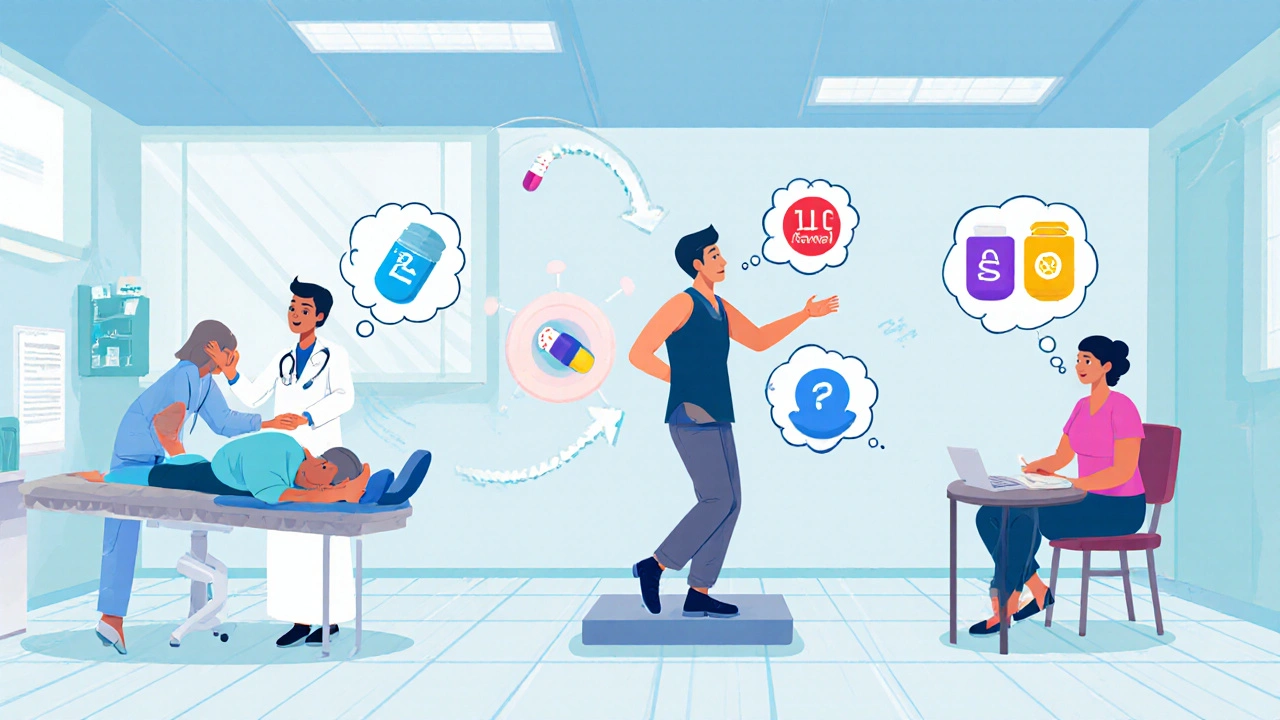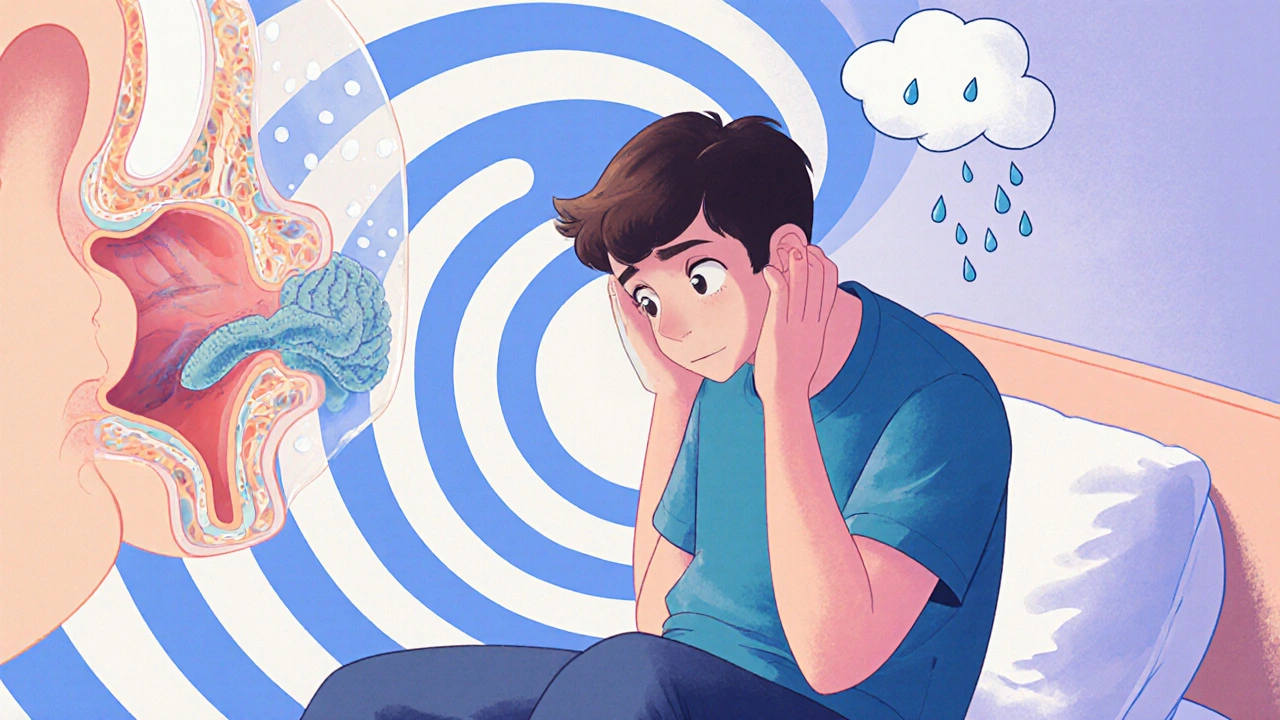Living with a constant sense that the world is spinning can feel like an endless roller‑coaster you never signed up for. When that dizzy spell doesn’t go away, the brain starts to wear down, and many people find themselves slipping into a low mood that lasts weeks or months. This article explains why vertigo and depression often travel together, how the body and mind are linked, and what you can do to break the cycle.
What Is Vertigo?
Vertigo is a sensation of spinning, tilting, or moving when you’re actually still. The feeling originates from the vestibular system - a network of fluid‑filled canals and tiny hair cells in the inner ear that tells the brain where the head is in space.
Vertigo can be brief, like the wobble you feel after standing up too quickly, or chronic, lasting days, weeks, or even years. Chronic dizziness often stems from conditions such as benign paroxysmal positional vertigo (BPPV), Menière’s disease, vestibular migraine, or vestibular neuritis.
What Is Depression?
Depression is a mood disorder marked by persistent sadness, loss of interest, fatigue, and trouble concentrating. It goes beyond occasional blues - it interferes with daily activities, sleep, appetite, and even physical health.
While genetics, brain chemistry, and life events all play a role, chronic physical ailments are powerful triggers. When the body constantly tells you it’s unsafe, the mind often follows.
Why Chronic Dizziness Fuels Low Mood
Three main pathways connect vertigo to depression:
- Physiological stress response: Repeated dizziness spikes the body’s stress hormones, especially cortisol. Long‑term elevation of cortisol can damage the hippocampus, a brain region crucial for mood regulation.
- Activity avoidance: People with vertigo often limit their movements to avoid falls. This leads to reduced social contact, exercise, and daylight exposure - all proven mood boosters.
- Loss of control: Unpredictable episodes create a sense of helplessness. When you can’t trust your own balance, anxiety builds, and anxiety frequently morphs into depression.
Studies from the American Academy of Otolaryngology (2023) show that 45 % of patients with chronic vestibular disorders meet criteria for major depressive disorder, a figure three times higher than the general population.
Key Risk Factors
- Age: Adults over 60 experience both vertigo and depression more often, partly due to age‑related inner‑ear degeneration.
- Gender: Women are twice as likely to develop vestibular migraine, which carries a higher depression risk.
- Comorbid conditions: Migraine, anxiety disorders, and chronic pain amplify the emotional toll.
- Medication side‑effects: Some antihistamines and sedatives can worsen mood.

How Doctors Diagnose the Overlap
When you walk into an otolaryngology or neurology clinic, the clinician follows a two‑pronged approach.
- Vestibular assessment: Tests like the Dix‑Hallpike maneuver, video‑head impulse test (vHIT), and computerized dynamic posturography pinpoint the source of dizziness.
- Mental‑health screening: Standardised questionnaires such as the PHQ‑9 (for depression) and GAD‑7 (for anxiety) are administered to gauge emotional impact.
Combining these results helps specialists decide whether to treat the ear problem, the mood problem, or both simultaneously.
Treatment Options That Attack Both Problems
Because the link is bidirectional, the most effective plans address both the vestibular dysfunction and the depressive symptoms.
Vestibular Rehabilitation Therapy (VRT)
VRT is a set of custom exercises that challenge balance and eye‑movement coordination. Over 6‑12 weeks, patients learn to rely on visual cues and proprioception instead of a faulty inner ear. Research in the Journal of Neurophysiology (2024) shows VRT reduces depressive scores by an average of 4 points on the PHQ‑9.
Medication Management
When vertigo stems from inflammation or migraine, doctors may prescribe:
- Betahistine - improves inner‑ear blood flow.
- Propranolol or topiramate - migraine‑specific prophylaxis.
- Selective serotonin reuptake inhibitors (SSRIs) - treat depression and can also dampen vestibular hyper‑excitability.
It’s crucial to coordinate with both an otolaryngologist and a psychiatrist to avoid drug interactions.
Cognitive‑Behavioral Therapy (CBT)
CBT helps reframe catastrophic thoughts (“I’ll fall and break my hip”) and builds coping skills. A 12‑session CBT course for vestibular patients reduced anxiety by 30 % and lowered PHQ‑9 scores by 5 % on average.
Lifestyle Adjustments
- Gentle aerobic activity: Walking, stationary cycling, or swimming improves circulation to the inner ear and releases endorphins.
- Sleep hygiene: Consistent bedtime, low‑light environments, and avoiding alcohol before sleep help both balance and mood.
- Hydration and low‑sodium diet: Beneficial for Menière’s disease and can reduce overall fatigue.
Practical Tips for Daily Living
- Set up a safe home base: Keep nightlights on, use non‑slip mats in the bathroom, and arrange furniture to allow clear pathways.
- Use visual anchors: When walking, focus on a fixed point ahead to stabilise the vestibulo‑ocular reflex.
- Practice grounding: Simple breathing exercises (4‑2‑4 pattern) can lower cortisol spikes during an episode.
- Track triggers: A symptom diary helps you identify foods, stressors, or head positions that worsen dizziness.
- Stay socially connected: Even short phone calls or video chats prevent isolation.

When to Seek Professional Help
If you notice any of the following, schedule an appointment promptly:
- Vertigo lasting more than a few minutes without clear cause.
- New or worsening depressive symptoms such as hopelessness, suicidal thoughts, or drastic changes in sleep/appetite.
- Frequent falls, especially if they result in injury.
- Difficulty performing daily tasks - work, school, or caregiving responsibilities.
Early intervention can stop the vicious cycle before it entrenches.
Frequently Asked Questions
Can vertigo cause depression on its own?
Yes. Chronic dizziness triggers stress hormones, limits activity, and creates a sense of helplessness - all of which can independently lead to depressive episodes.
Is medication always needed?
Not always. For many patients, vestibular rehab combined with psychotherapy and lifestyle changes reduces both vertigo and mood symptoms. Medication is reserved for severe cases or specific underlying conditions.
How long does vestibular rehabilitation take?
Typical programs run 6‑12 weeks, with home exercises performed daily. Progress varies; some feel improvement within a few sessions, others need a longer course.
Can antidepressants worsen vertigo?
Most SSRIs are neutral or even helpful for vestibular hyper‑excitability. However, certain sedatives or tricyclics can affect blood pressure and balance, so a doctor’s supervision is essential.
What self‑help tools are most effective?
A combination of a symptom diary, gentle balance exercises (like tandem walking), and daily mindfulness breathing yields the best results for most people.
Bottom Line
Vertigo isn’t just a physical problem, and depression isn’t merely a mental hiccup. The two feed each other through hormones, activity levels, and feelings of control. By recognizing the link early, seeking both vestibular and mental‑health care, and adopting targeted lifestyle habits, most people can regain stability and lift their mood.
Remember: you don’t have to navigate the spin alone. A coordinated team of an otolaryngologist, a neurologist, and a mental‑health specialist can map a clear path forward.

Ryan Spanier
I've been battling chronic vertigo for over a year now, and the mood swings came as a silent storm. The first thing I learned is that the brain treats persistent dizziness like a constant alarm, flooding the system with cortisol. That hormonal overload quietly gnaws at the hippocampus, making it harder to keep a positive outlook. I started keeping a simple symptom diary, noting the time of each episode, my food, and my stress level. Over weeks, patterns emerged – late‑night caffeine spikes and lack of sunlight were clear aggravators. Armed with that data, I introduced short, bright‑light walks at sunrise, which lifted both my balance and my spirits. In parallel, I consulted a vestibular therapist who taught me gaze‑stabilization drills that feel like tiny brain workouts. The exercises, done twice daily, gradually rewired my reliance on visual cues instead of the faulty inner‑ear signals. On the mental side, I paired the physical rehab with weekly CBT sessions, focusing on reframing the catastrophic thought “I’ll fall and break something.” My therapist helped me replace that dread with a mantra: “I’m safe when I move mindfully.” The combination of vestibular rehab and cognitive work shaved five points off my PHQ‑9 score within two months. Medication was never a first resort for me, but when my physician added a low‑dose SSRI, the lingering anxiety softened enough to let the rehab stick. I also cut back on salty snacks and stayed well‑hydrated, which surprisingly eased the pressure in my ears that sometimes triggered the spins. Social support played a huge role; regular video calls with friends prevented the isolation that can deepen depression. If you’re reading this and feel trapped in the spin, know that a coordinated plan of movement, light, therapy, and community can break the cycle. Keep tracking, keep moving, and give yourself credit for each small victory; the brain is remarkably adaptable.
Abhinav Moudgil
I've seen the cascade of vertigo‑induced stress unfold like a vivid tapestry of cause and effect. The vestibular system, when misfiring, sends a perpetual signal that the world is untethered, and the brain responds by cranking up cortisol, the classic stress hormone. This hormonal surge does not merely unsettle your equilibrium; it also clouds the neurotransmitters that sustain mood. A disciplined regimen of vestibular rehabilitation, combined with mindful breathing, can act as a dual‑action antidote. Think of each gaze‑stabilization exercise as a brushstroke that repaints the brain’s perception of safety. Augment this with bright‑light exposure in the early morning to synchronize your circadian rhythm, which in turn bolsters serotonin production. When the physical and chemical facets are addressed together, depression symptoms often recede dramatically. Remember, consistency is the keystone; even brief daily sessions accumulate into substantial neuroplastic change. Keep the momentum, and you’ll navigate the world with steadier steps and a brighter mind.
Miah O'Malley
Vertigo reminds us that our sense of being grounded is an illusion crafted by the inner ear, a delicate sensor that can betray us with phantom spins. When that illusion shatters, the mind scrambles for certainty, often stumbling into the dark valleys of depression. Yet within that turmoil lies an invitation to question what we truly rely on for stability. Does the world spin because of external forces, or because our perception chooses to dance? The answer, I think, is both-a delicate duet of physiology and consciousness. Embracing this paradox can soften the fear that fuels helplessness, allowing us to seek balance in new, unexpected ways. Meditation, gentle movement, and honest self‑inquiry become tools to re‑anchor the soul. In that re‑anchoring, the dizzy haze lifts, revealing a clearer horizon.
Bradley Allan
Wow, the depth of that personal journey is truly inspiring!!! It really shows how neglecting our inner ear can spiral into a full‑blown emotional abyss!!! The dedication to both physical rehab and mental therapy is a testament to human resilience!!! Keep fighting the good fight, and let others see that recovery is possible!!!
Kyle Garrity
Seeing how you combined the exercises with therapy really hits home. It’s amazing how small, consistent steps can add up. Your story gives me hope that I can manage my own symptoms too.
brandon lee
Sounds like you’ve got a solid plan, keep at it
Joshua Pisueña
Totally agree the daily light walks make a big difference they boost mood and help the ear function keep it up and stay consistent
Ralph Barcelos de Azevedo
Honestly, many people overlook how serious chronic dizziness can be. It's not just a minor annoyance; it's a full‑blown health crisis that can topple one's entire life. If we don't treat both the vestibular symptoms and the mood disturbances together, we risk a perpetual loop of misery. We need to demand integrated care from healthcare systems, not compartmentalized treatments. This is a matter of public health, not an optional extra.
Peter Rupar
THIS IS EXACTLY WHY DOCTORS KEEP SEGREGATING TREATMENTS! PEOPLE END UP SICKER BECAUSE THEY DON'T SEE THE BIG PICTURE! WE NEED ONE‑STOP SOLUTIONS OR WE'LL KEEP FAILING EVERY ONE OF US!
Nikita Shue
Hey, I’ve been juggling vertigo and low mood myself, and I’ve found that short, guided breathing sessions before bed can calm the cortisol spikes. Pair that with gentle yoga stretches in the morning, and you’ll notice less dizziness and a brighter outlook. Keep the routine simple and consistent, and give your body time to adapt. Small wins add up.
Stephen Wunker
While breathing and yoga are fine, the real issue is that most research ignores the socioeconomic factors that drive chronic stress. If you’re not addressing income inequality, you’ll never solve the root cause of the hormonal cascade. So, all those personal hacks are just band‑aid on a broken system.
Jhoan Farrell
Thanks for sharing all these tips 😊 It really helps to see practical steps that actually work. I’m going to try the morning walks and the diary tonight 🌅📝
Jill Raney
One must wonder whether the very institutions promoting these "solutions" are not part of a larger agenda to keep patients dependent on endless therapies. The data is thin, the recommendations vague-perhaps a subtle strategy to monetize chronic conditions. I remain skeptical.
Caleb Burbach
From a philosophical standpoint, the interplay between vestibular function and affective states illustrates the mind‑body unity that many modern paradigms overlook. Empirically, integrating vestibular rehabilitation with CBT yields measurable reductions in PHQ‑9 scores, a fact supported by recent peer‑reviewed studies. Practically, patients can adopt a three‑pronged approach: structured balance exercises, regulated light exposure, and cognitive reframing techniques. Consistency is paramount; even brief daily sessions catalyze neuroplastic adaptation. Remember, progress is incremental, not instantaneous, and each small victory compounds toward lasting stability. 🌟